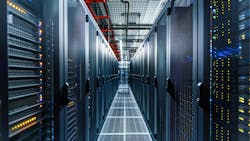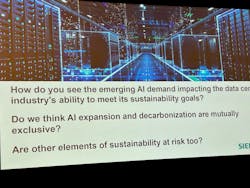The Data Center Energy Tri-Lemma: Matching Unprecedented Growth with Affordable Sustainability
What’s happening at the crossroads of data center growth and energy capacity sometimes looks like a race to the top and sometimes like a crash waiting to happen.
Imagine rack density accelerating to where the distribution voltage might rise from 240V to 600V and beyond. Imagine a 1-GW supercomputer on the near horizon. Imagine the electric power capacity of Arizona, which took more than 100 years to reach 11 GW, doubling that in the short term just to satisfy new data center construction that will need twice again that much power in only a few more years.
It's all so much to take in. Thus, it’s not so hard to imagine fear and trepidation among utilities and developers alike. Numbers staggering; minds blown; futures uncertain.
Thursday’s early sessions at the Data Center Frontier Trends Summit featured panels taking that fear and trepidation head on. The first-ever Trends Summit at the Hyatt Regency in Reston, Virginia—a state which is home to more data center capacity than any other—focused on ways forward into a future that’s moving faster than ever thought possible.
“We don’t have all the answers yet,” Vance Peterson, global solutions architect at Schneider Electric, said during the keynote Thursday. “My crystal ball tells me we’ve got to find those answers.”
The growth projections do seem overwhelming to many, although exciting to those who believe the growth of artificial intelligence (AI) and cloud-based services will be highly positive economic drivers in the future. In a short of mega scale version of Moore’s Law, data center capacity in the U.S. should double from 2022 to almost 40 GW by 2030.
Forty-plus GW are the same as close to 30 new nuclear power units, or 80 gas-fired turbines. It’s equal to more than 300,000 acres of additional solar farms.
The data center trilemma: Energy, costs and sustainability
The environmental challenge is hard to fathom, as data centers require not only tremendous amounts of energy, but also water for cooling and land for siting. These are growth projections that utilities did not factor in only a few years ago.
“The utilities are getting scared,” Karen Petersburg, vice president of development and construction for PowerHouse Data Centers, said in another Trends Summit session. “They’re getting smarter and also scared. They see what’s happening.”
Data center giants such as Amazon, Microsoft and Meta are contributing a large part through long-term renewable energy power purchase agreements. These PPAs do not usually power the data centers directly, but the billions of investment by the tech firms de-risks projects and ensures deployment into the utility-scale grid.
So, what can be done about a power “tri-lemma,” as Ciaran Flanagan, global head of data centers for Siemens, termed the balancing of the need for reliable energy, steep costs and sustainability goals? In some cases, industry leaders are walking back some of their earlier and lofty decarbonization promises, but others see hope in different ways of satisfying the insatiable energy demand coming from the AI and cloud-based upheaval.
One of the ways, which could involve a greater shift to microgrids for dedicated on-site power, is shifting from alternate current to direct current (DC), Chris Sharp, chief technical officer for project developer Digital Realty, said in the keynote. Direct current could facilitate a more effective and efficient means of utilizing renewable energy and hybrid resources such as solar and storage combinations.
“It has to be done,” Sharp pointed out. “DC is on the precipice.”
This support for DC echoes recommendations made by microgrid experts last year at the massive RE+ conference in Las Vegas. DC is more efficient when generation is close to the load, proponents say.
Overcoming interconnection queues and workforce challenges
Innovating on the energy efficiency front also should pay dividends in handling the data center expansion in a safe and productive matter. New ways of cooling and utilizing excess heat could pave the way for more efficient and safer data centers.
Introducing more modularity and standardization in data center construction could also create greater efficiencies in time and interconnection processes, Chris McLean, principal at Critical Facilities Group, offered. Otherwise, the current workforce shortage makes some of these development goals seem impossible.
“There’s only so much elasticity in what we’re doing,” McLean said. “We’ve got a people problem in the industry. There’s not enough qualified humans to do the stuff we’re trying to do right now.”
Finding the way forward to match data center to energy
All of this is true, and challenges abound. But among the industry veterans at the Data Center Frontier Trends Summit the confidence is still high that they will be solved through focus and determination.
“Our industry, as a whole, takes up these challenges, eats them up and spits them out as something better,” Petersburg said.
New regulatory layers, made necessary by the unprecedented growth of AI and its potential for both good and evil, should be careful to be helpful on both side but not impede innovation on the other, panelists agreed.
The interconnection queue for new power projects, particularly distributed energy resources, is already several years long. The data center industry capacity and load profile is changing so fast—and growing ever more crucial to national security—that these delays are not acceptable and create the tri-lemma mentioned earlier.
“We can’t build fast enough,” McLean said. “There’s not enough electricity on earth to satisfy the demand.”
These current challenges require completely unique solutions which, in many cases, may not even be invented yet.
Not satisfying that demand in the long run, though, is not an option. AI is happening, data centers are happening, and the energy supply side must evolve and expand to make it happen.
Minds are blown now, but the consensus at the Data Center Frontier Trends Summit is that they will re-form and unite anew to think of ways to make it happen.
About the Author
Rod Walton, EnergyTech Managing Editor
Managing Editor
For EnergyTech editorial inquiries, please contact Managing Editor Rod Walton at [email protected].
Rod Walton has spent 17 years covering the energy industry as a newspaper and trade journalist. He formerly was energy writer and business editor at the Tulsa World. Later, he spent six years covering the electricity power sector for Pennwell and Clarion Events. He joined Endeavor and EnergyTech in November 2021.
Walton earned his Bachelors degree in journalism from the University of Oklahoma. His career stops include the Moore American, Bartlesville Examiner-Enterprise, Wagoner Tribune and Tulsa World.
EnergyTech is focused on the mission critical and large-scale energy users and their sustainability and resiliency goals. These include the commercial and industrial sectors, as well as the military, universities, data centers and microgrids. The C&I sectors together account for close to 30 percent of greenhouse gas emissions in the U.S.
He was named Managing Editor for Microgrid Knowledge and EnergyTech starting July 1, 2023
Many large-scale energy users such as Fortune 500 companies, and mission-critical users such as military bases, universities, healthcare facilities, public safety and data centers, shifting their energy priorities to reach net-zero carbon goals within the coming decades. These include plans for renewable energy power purchase agreements, but also on-site resiliency projects such as microgrids, combined heat and power, rooftop solar, energy storage, digitalization and building efficiency upgrades.


